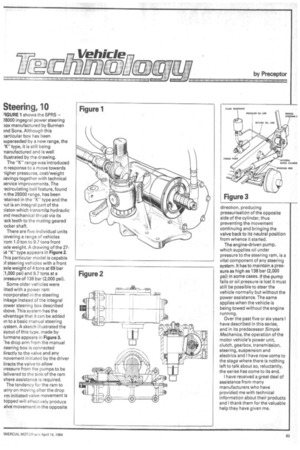Steering, 10
Page 65

If you've noticed an error in this article please click here to report it so we can fix it.
IIGURE 1 shows the SPRS — 28000 ingegral power steering aox manufactured by Burman and Sons. Although this )articular box has been ;uperseded by a new range, the 'K" type, it is still being -nanufactured and is well Ilustrated by the drawing. The "K" range was introduced n response to a move towards Agher pressures, cost/weight iavings together with technical iervice improvements. The .ecirculating ball feature, found n the 28000 range, has been -etained in the "K" type and the -nit is an integral part of the Aston which transmits hydraulic md mechanical thrust via its .ack teeth to the mating geared ocker shaft.
There are five individual units ;overing a range of vehicles rom 1.0 ton to 9.7 tons front lxle weight. A drawing of the 27i4 "K" type appears in Figure 2. rhis particular model is capable )f steering vehicles with a front axle weight of 4 tons at 69 bar 1,000 psi) and 9.7 tons at a ressure of 138 bar (2000, psi). Some older vehicles were itted with a power ram ncorporated in the steering inkage instead of the integral )ower steering box described above. This system has the advantage that it can be added )n to a basic manual steering iystem. A sketch illustrated the ayout of this type, made by lurmans appears in Figure 3. he drop arm from the manual iteering box is connected lirectly to the valve and any novement initiated by the driver lirects the valve to allow aressure from the pumps to be lelivered to the side of the ram vhere assistance is required. The tendency for the ram to iarry on moving after the drop rm initiated valve movement is topped will effectively produce alvi movement in the opposite
direction, producing pressurisation of the opposite side of the cylinder, thus preventing the movement continuing and bringing the valve back to itS neutral position from whence it started.
The engine-driven pump, which supplies oil under pressure to the steering ram, is a vital component of any steering system. It has to maintain a pressure as high as 138 bar (2,000 psi) in some cases. If the pump fails or oil pressure is lost it must still be possible to steer the vehicle normally but without the power assistance. The same applies when the vehicle is being towed without the engine running.
Over the past five or six years I have described in this series, and in its predecessor Simple Mechanics, the operation of the motor vehicle's power unit, clutch, gearbox, transmission, steering, suspension and electrics and I have now come to the stage where there is nothing left to talk about 90, reluctantly, the series has come to its end.
I have received a great deal of assistance from many manufacturers who have provided me with technical information about their products and I thank them for the valuable help they have given me.




























































































